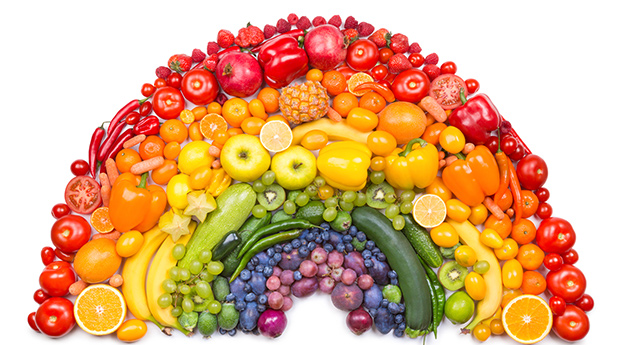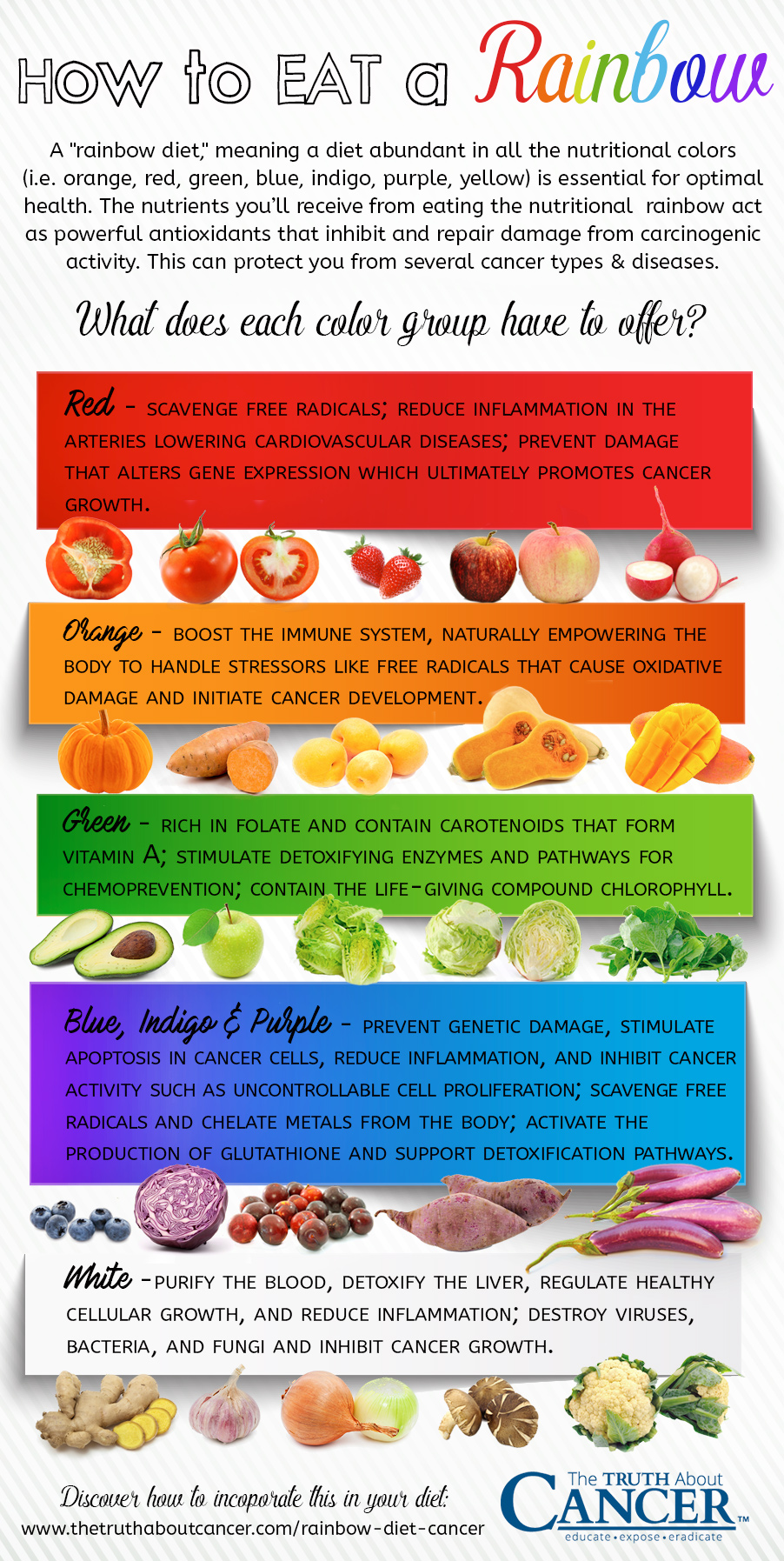Fruits and vegetables get their color from the micronutrients they contain. Vitamins and phytonutrients responsible for providing these colorful hues vary in each and every plant source. This is why it is so critical for you to eat all the colors of the rainbow. A “rainbow diet,” meaning a diet abundant in all the nutritional colors (i.e. yellow, orange, red, green, blue, indigo, purple) is essential for optimal health.
The nutrients you’ll receive from eating the nutritional rainbow act as powerful antioxidants that inhibit and repair damage from carcinogenic activity. This can protect you from several cancer types. These powerful antioxidants help to establish a strong defense system to support a bulletproof immune system and better equip your body to combat the development of disease.
Plant-Based Rainbow Diets Reduce Cancer Risks
When you sit down to eat do you see a rainbow on your plate? No single nutrient can defeat cancer on its own without the assistance from a variety of others to support life-giving processes within your cells. Insufficient dietary factors are considered the primary cause of cancer worldwide − associated with cancers like colorectal and prostate cancer by 70%.
Epidemiological studies provide support that individuals who consume a plant-based diet have a nutritional advantage over conquering chronic degenerative diseases such as:
- Leukemia
- Cancers of the brain, breast, lung, skin, prostate, and gastrointestinal tract
- Diabetes
- Cardiovascular disease
Part of the cancer protective influences that plants provide are due to their alkalizing properties. Human survival requires an alkaline pH of 7.365 in the blood. The modern Western diet however is loaded with an abundance of acidic foods like sugar, conventional dairy, and processed meats that upset the balance of blood pH leading to disease.
Alkaline diets, or those primarily plant-based (rich in fruits and vegetables), have been found to support skeletal muscle and prevent osteoporosis. They have also been found to improve cardiovascular health, boost brain function, regulate healthy body fat, treat back pain, and improve the therapeutic effectiveness of cancer treatments.
The Health Benefits of Eating the Rainbow
White:
Unlike manufactured food in which white indicates sugar, bleached flour, and food drained of its nutrient profile, white foods in nature are highly nutritious and healing to the body.
White foods purify the blood, detoxify the liver, regulate healthy cellular growth, and reduce inflammation that can damage the vascular system. Foods that comprise the onion family are loaded with the anti-inflammatory compound allicin. Allicin is a sulfur containing compound that destroys viruses, bacteria, and fungi and inhibits cancer growth.
Mushrooms contain a variety of anti-cancer benefits and are regarded as a nutraceutical food. Compounds in mushrooms have been used in the medical treatment of cancer, diabetes, allergies, and bacterial infections. They play a critical role in fighting inflammation, preventing proliferation of cancer cells, turning on apoptosis, and inhibiting cancer promoting enzymatic processes.
White Fruits & Vegetables: Leeks, onions, garlic, scallions, apples, white-fleshed sweet potato, cauliflower, mushrooms, and ginger. Just as you should eat foods characteristic of all the colors of the rainbow, you should also consider incorporating a variety of each food type into your diet. For instance, there are over a dozen types of mushrooms that possess different potential to fight cancer.
Green:
Green fruits and vegetables are abundant in numerous plant compounds that improve health and healing in the body. Dark leafy greens are rich in folate and have been shown to improve fertility. They contain carotenoids that are taken up by the body and formed into retinol or vitamin A. Cruciferous veggies contain sulfur compounds isothiocyanates and sulforaphane that stimulate detoxifying enzymes and pathways for chemoprevention.
Perhaps the greatest nutritional benefit you will receive from adding green fruits and vegetables into your diet is from the life-giving compound they contain called chlorophyll.
Chlorophyll has been shown to regulate hormones associated with hunger such as ghrelin, improve insulin levels, and inhibit pro-inflammatory compounds that give rise to disease. Chlorophyll upregulates natural detoxification pathways and provides wound healing benefits to damage tissue.
Green Fruits & Vegetables: Collard, turnip and mustard greens, sea vegetables, avocado, swiss chard, romaine and iceberg lettuce, kale, spinach, Granny Smith apples, and arugula. The best way to prevent against nutrient loss in these foods is to avoid cooking methods that add heat including boiling or stir-frying. The best way to maintain chlorophyll and other nutrients like vitamin C in green produce is to steam if you must apply heat or otherwise consume raw.
Blue, Indigo, and Purple:
Anthocyanins contribute to the dark blue and purple pigmentation in food. Researchers believe that a deficiency in this flavonoid is a major factor implicated in the high cancer rates today. Anthocyanins are responsible for preventing genetic damage, stimulating apoptosis in cancer cells, reducing inflammation, and inhibiting cancer activity such as uncontrollable cell proliferation.
The anti-cancer health benefits don’t end there. Anthocyanins exhibit cytotoxic effects in cancer cells of the colon, liver, breast, and leukemia − to name only a few. Anthocyanins scavenge free radicals and also function as an effective chelating agent for removing metals from the body and assisting in other detoxification pathways. Powerful antioxidant system like glutathione and related enzymes are activated in the presence of anthocyanins.
Blue, Indigo, and Purple Fruits & Vegetables: Eggplant, blueberries, plums, red cabbage, cranberries, blackberries, and purple-fleshed sweet potato.
Red:
Red hued fruits and veggies are dominated by the antioxidants anthocyanin, lycopene, and vitamin C. These plant compounds counteract the effects of reactive oxygen species by scavenging free radicals before they cause tissue trauma. Lycopene is a carotenoid that produces the red pigmentation in plants and is the most powerful free radical scavenger in its family.
Eating a diet rich in lycopene reduces inflammation in the arteries lowering cardiovascular diseases. Lycopene can even prevent damage that alters gene expression which ultimately promotes cancer growth. Most evidence to date supports that lycopene reduces the occurrence of prostate cancer, as well as lung, stomach, and breast cancer.
The availability of lycopene in the foods you eat is affected by both storage and processing. For example, light and oxygen exposure degrades lycopene significantly, reducing its concentration in the food you are consuming. On the other hand, increased temperature releases lycopene so that your body can better absorb the powerful nutrient once ingested. Furthermore, lycopene requires a fat to be taken up by the body.
Red Fruits & Vegetables: Tomatoes, strawberries, watermelon, raspberries, dark grapes, apples, red cabbage, beets, rhubarb, red peppers, radishes, and cherries. Consider adding a homemade salad dressing to fresh tomatoes, steaming cabbage and beets before adding them to a slaw, and avoiding cutting up vegetables far in advance of meal preparation.
Orange:
Beta-carotene is the primary antioxidant that gives some foods their bright orange color. Part of a family of compounds called carotenoids, beta-carotene can prevent against cancer of the stomach and esophagus. Beta-carotene boosts the response of the immune system, naturally empowering the body to handle stressors like free radicals that cause oxidative damage and initiate cancer development.
Beta-carotene may even be a powerful tool for preventing cancer deaths associated with abnormal epithelial cells as evident in lung cancer. It may also be helpful in reducing the current mortality rate affecting 90% of all cancer-related deaths.
Once beta-carotene is ingested, it is converted into retinol in the body, improving vision and night blindness. Excess intake increases stores of beta-carotene in fatty tissue rather than the liver. Although beta-carotene offers such powerful chemoprotective properties, the body’s need to reroute its overabundance highlights its desire to receive a variety of nutrients from a rainbow of colors.
Orange Fruits & Vegetables: Sweet potato, butternut squash, pumpkin, carrots, grapefruit, apricots, mango, papaya, and cantaloupe.
Tips for Adding More Color to Your Plate
Incorporate the rainbow into your diet by introducing a combination of fruits and veggies that you enjoy eating. Anticipating ways that you can add color to your plate will not only keep you encouraged to keep adding more variety, but will provide you with countless health benefits to reduce your risk of developing cancer.
Puree carrots into a paste and add to a homemade marinara sauce with diced white onion and green peppers. Prepare a tropical style guacamole by mixing in pineapple, mango, red onion, cucumbers, tomato, garlic, and lime zest into your mashed avocados. Toss salads with granny smith apples, cranberries, leeks, and alfalfa sprouts drizzled in macerated blackberries and lemon juice for a colorful side dish.
Are you eating a rainbow diet? What are your favorite plant-based foods that you enjoy? Please share in the Comments section below.
Article Summary
Fruits and vegetables get their color from the micronutrients they contain. This is why it’s critical to eat all the colors of the rainbow − the vitamins and phytonutrients responsible for providing color vary in each and every plant source.
The nutrients you’ll receive from eating the nutritional rainbow act as powerful antioxidants that inhibit and repair damage from carcinogenic activity.
Insufficient dietary factors are considered the primary cause of cancer worldwide, and are especially associated with cancers like colorectal and prostate cancer.
Human survival requires an alkaline pH of 7.365 in the blood. The modern Western diet is loaded with an abundance of acidic foods. A plant-based diet, on the other hand, has alkalizing properties.
Incorporate the rainbow into your diet by introducing a combination of fruits and veggies that you enjoy eating. This will provide you with countless health benefits to reduce your risk of developing cancer.




















Spinach, kale,broccoli,gia lan,cilantro,parsley,cucumber,tumeric,cumin,ginger,two bananas,one pear or an apple, yogurt and two cups of filtered water. Daily smoothie morning drink, I feel great after drinking that one
Good morning
A vey quick question for now….lycopene requires a fat to be ingested with it in order for it to be of use in the body…any fat ? I favour coconut oil an pumpkin seed oil both of which I love.
Blessings
Jackie
Coconut oil is grand and also delicious–thanks so much for this: The Rainbow diet by Chris Woollams is reviewed on the cansurviving site and there are lots of recipes for using all these wonderful natural offerings to keep us healthy or help us as cansurvivors to heal and be happy…
Hello Family; Thank you for this good advice.Yes all this Is important part and another important part is Joy, Peace and Happiness and Harmony, without these in our lives there is stress and stress can be very unhealthy for the body. Sometime someone can bring us these things and sometimes it is Yoga or a hot bath and meditation,at times we can be our own Saviors. We must place ourselves as important too because with out us there is no help for others. ” If we don’t take time for health, we will take time for sickness”. In a airplane we are told to put our air masks on first and then tend to others. Just sharing. God I Love You, You ARE Myself. alan
I do eat those different color of fruits and vegetables, but I do not know whether I am eating the rainbow diet or not. I never really paid attention. What does detoxifying tea do? Does it do good or harm to the body?
I HAVE ORDERED YOUR SPECIAL POWDER, NOW MY QUESTION IS THIS…WHEN I START TAKING IT, WILL I STILL HAVE TO TAKE ALL MY DOZENS OF VITAMINS –OR WILL THIS POWDER DO IT ALL.
Hi Irene,
Are you referring to the EpiGreens powder from Epigenetic Labs? If so, please reach out to their customer support team: https://support.epigeneticlabs.com/submit_ticket
“Epidemiological studies provide support that individuals who consume a plant-based diet have a nutritional advantage over conquering chronic degenerative diseases…” I really dislike seeing this kind of comparative statement without mentioning what is being compared. Nutritional advantage compared to what? Without more clarification I can only assume it was the Standard American Diet (aka SAD). Of course, almost every special diet provides an advantage compared to SAD. So please don’t try to make this seem like “plant-based” (code term for vegan) is the best diet for all humans. Animal foods contain many valuable nutrients too – for example eggs contain choline and betaine plus the vital cholesterol (which contrary to popular but unsubstantiated belief does NOT cause heart disease). Small fish like sardines and herring contain the omega-3 fats DHA and EPA. It’s also difficult to get enough fat into the diet without animal assistance unless one eats large amounts of coconuts, avocados, olives, chocolate, and macadamia nuts, none of which are locally grown in most of the US. A rainbow of plants is of course very healthy to consume, but we must not make the argument that plants (and fungus like mushrooms) is all we should eat. A real foods diet includes animals too.
I love this way of looking at a healthy, plant-based diet. It’s so simple to remember, and yet so powerful at the same time. I’m constantly amazed at the health-giving substances that are being discovered in plants all the time.
My favourite rainbow foods would have to be leafy greens and berries. I think I would live on berries full time if I could get easy and cheap access to them all year ’round 🙂